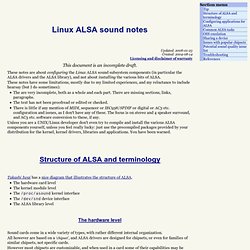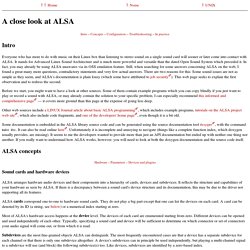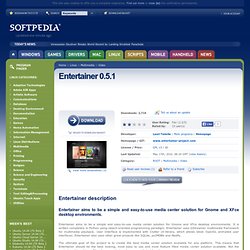

Introduction to Sound Programming with ALSA. ALSA stands for the Advanced Linux Sound Architecture.

It consists of a set of kernel drivers, an application programming interface (API) library and utility programs for supporting sound under Linux. In this article, I present a brief overview of the ALSA Project and its software components. The focus is on programming the PCM interfaces of ALSA, including programming examples with which you can experiment. You may want to explore ALSA simply because it is new, but it is not the only sound API available. ALSA is a good choice if you are performing low-level audio functions for maximum control and performance or want to make use of special features not supported by other sound APIs. The ALSA Project was started because the sound drivers in the Linux kernel (OSS/Free drivers) were not being maintained actively and were lagging behind the capabilities of new sound technology.
During development of the 2.5 series of Linux kernel, ALSA was merged into the official kernel source. Linux ALSA sound notes. Updated: 2008-01-23Created: 2004-08-14 Licensing and disclaimer of warranty This document is an incomplete draft.

These notes are about configuring the Linux ALSA sound subsystem components (in particular the ALSA drivers and the ALSA library), and not about installing the various bits of ALSA. These notes have some limitations, mostly due to my limited experiences, and my reluctance to include hearsay (but I do sometimes): The are very incomplete, both as a whole and each part. Unless you are a UNIX/Linux developer don't even try to compile and install the various ALSA components yourself, unless you feel really lucky: just use the precompiled packages provided by your distribution for the kernel, kernel drivers, libraries and applications. Structure of ALSA and terminology Takashi Iwai has a nice diagram that illustrates the structure of ALSA.
The hardware card level The kernel module level The /proc/asound kernel interface The /dev/snd device interface The ALSA library level output. A close look at ALSA. Intro -- Concepts -- Configuration -- Troubleshooting -- In practice Intro Everyone who has more to do with music on their Linux box than listening to stereo sound on a single sound card will sooner or later come into contact with ALSA.

It stands for Advanced Linux Sound Architecture and is much more powerful and versatile than the dated Open Sound System which preceded it. In fact, you may already be using ALSA unawares via its OSS emulation feature. Still, when searching for some answers concerning ALSA on the web, I found a great many more questions, contradictory statements and very few actual answers. ). Before we start, you might want to have a look at other sources. . — it covers more ground than this page at the expense of going less deep. Other web sources include a LINUX Journal article about basic ALSA programming , which includes example programs, tutorials on the ALSA project web site , which also include code fragments, and one of the developers' home page.
Alsa. Linux Audio and Sound - Application and Software Index [Linux-Sound] Gimmix. Music Player for GTK+ Download Entertainer 0.5.1 for Linux - Entertainer aims to be a simple and easy-to-use media center solution for Gnome and XFce desktop environments. Entertainer aims to be a simple and easy-to-use media center solution for Gnome and XFce desktop environments.

It is written completely in Python using object-oriented programming paradigm. Entertainer uses GStreamer multimedia framework for multimedia playback. A classic player for a modern era. Ario - Captures d'écran. Audacious - An Advanced Audio Player.